The following day I got up with no hurry and well rested. I had breakfast with the female part of the family and then I went to the centre of the city with Señora Maria. First we went to some place where some people who represent the unemployed gather and then Señora Maria gave a short speech there. She is an activist, ecologist, volunteer in the work with the poorest and she fights for the rights of peasants and the Aymara. It was all more than interesting. She told them that they should unite and jointly fight for their rights, not through strikes, marches or blockages, but by working hard on making their situation better. She said that they had to preserve their rivers and lakes, and not throw garbage into them. They should eat their own apples, not the ones imported from abroad. And finally, and this made quite an impression on me, she was in favour of all Bolivian embassies being closed for “they don’t do anything.”
Later we left our “party comrades” (there was lots of greeting and kissing both before and after the meeting) and we went to a centrally located square with a number of stands selling different local handicrafts and products made of wool and wood, herbal teas and food. Having cordially greeted some acquaintances of Señora Maria here as well, the two of us went to a farmers’ market. There we bought different things and I took an opportunity to try tuna – a cactus fruit. I didn’t touch it in order not to get pricked, but the seller peeled it skilfully for me. There are a lot of hard seeds inside, but they are not a problem. The taste was very pleasant.
After our visit to the market, we got into a taxi and went back home. Although it was a work day, soon the whole family got together, including also Javier, another brother who didn’t live with the family at the time. I was particularly impressed by the prayer before lunch. In my country we don’t have that, but it is in fact very nice to hear positive things, expressions of gratitude and the voicing out of good wishes. Lunch is a very important institute here. In my country, we may still have “Sunday lunch,” but here there are bigger traffic jams around lunchtime than when people go to work or return from it. Whatever is being done, it is interrupted at the time for lunch or it is organized in such a manner that it is finished beforehand. Even shops tend to be closed on a massive scale at this hour.
Following the lunch, everybody scattered and I washed my hair and started to make plans how to visit many different places around Bolivia and still manage to get back to Peru on time. Then Gustavo took me to a nearby cafe and later we got together again to look at the photos he took in Tiwanaku the previous day. At the time I still used to make slides, so I had no idea what my photos would be like and I was glad to see those digital ones. I really enjoyed hanging around with Gustavo and he reminded me a lot of one of our family friends. It seems to me that even their voices are similar and that they look alike. But much more than this, they are both for me primarily the epitome of goodness and kindness, and this is in fact completely unrelated to anything they actually do. It is just something innate that radiates from them.
The next day I went again downtown with Señora Maria. First we went to the National Academy of Sciences of Bolivia, to the Inventors Association, where she, among other things, gave a TV interview. Namely, Señora Maria knows very well the plants that may be found in Bolivia and their nourishing and medicinal properties, and this also includes coca which she wants to promote, but finds it difficult to do so, on account of the negative propaganda. However, her main motto is: coca is not cocaine (coca no es cocaina). She believes that Bolivia could earn more from the legal use of coca than from gas, which I guess is the main source of revenue at the level of the state.
Then we went to a bank and again to the green market for some serious shopping. While at the market I started to take photos of the food, but the vendors protested quite a lot insisting they did not want to be in the photos. This is a frequent occurrence in Latin America. Sometimes they agree to being taken photos of against a consideration, but sometimes they would not be caught dead posing for photos. I’ve heard several times that there are still beliefs from the past times that photographs take away their souls. Be as it may, they often voice their disapproval or simply turn their backs and hide their faces.
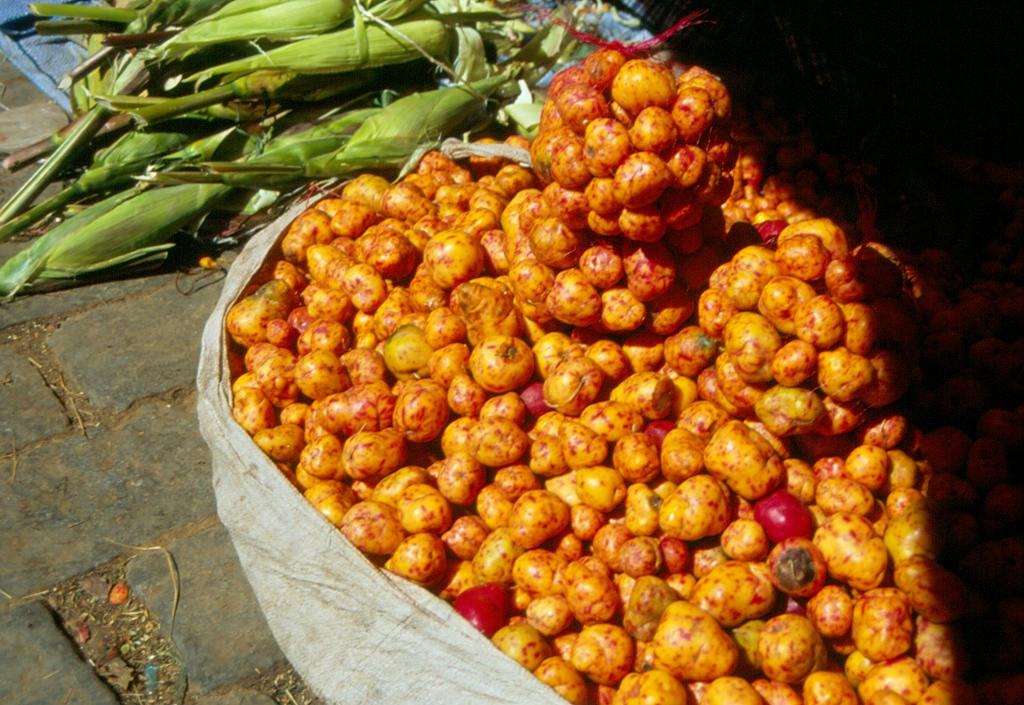 Papalisa
Papalisa
At the market, Señora Maria pointed out to me different vegetables that are grown locally. There is completely cute papalisa – bright yellow-pink roots the size and shape of which are reminiscent of new potatoes. And there are dried black and white potatoes. The black version is dried at night, in extreme cold, and during the day it is left out in the sun, thus additionally drying out and dehydrating. Señora Maria says that it is very healthy. The white one is obtained by being put into water. The water takes away its starch and what is left are these white potatoes that look like white stones. These are in fact ways to preserve and keep potatoes. There is also proper black potato, papa negra, but this one is not dry, only its natural colour is very dark.
Afterwards we went back home and brought into the kitchen all the things we had bought. And then we helped ourselves to some sweets Señora Maria had already made earlier – cookies and meringue made with ground coca leaves. Coca no es cocaina!
Then we had lunch followed by an unpleasant surprise: an old and quite big tooth filling fell out! I became hysterical at once at the very thought that my dear dentist was thousands of miles away. I spoke with my hosts and they referred me to a dentist who proved to be excellent for ad hoc situations. It was a young Cuban lady and I immediately started to calm down, since I knew from before that Cuba had one of the best medical faculties in Latin America and I decided to assume this applied to dentistry as well. The dentist worked very carefully, paying attention to details and I could see she used contemporary materials and technique. What was most important to me, however, was that we agreed she would do only a temporary repair that would hold until I got home (which indeed it did). Since everything went well, I returned to the Casa Duran all chirpy and the life became beautiful again.
The following day, the female part of the Duran family and I started to bake numerous pastries and prepare other types of dishes. Many of them included ingredients that originate in the Andes. This was the first time I heard of cañahua and quinoa. Cañahua grows only in the Andes, where it’s cold, and at the altitudes of above 3500 m. It is exceptionally nourishing and as it may easily be applied in its powdered form, it is even used for astronauts. Quinoa is similar to millet. It is also very nourishing and may be used either as seeds or as meal. Señora Maria is a top cook and she gave me instructions which I carefully applied. During some part of her life, she used to coach at cooking courses, so at one moment she said I was the best of all of her students! It was nice to hear praises, no question about it, but that did not matter too much. What really mattered was that I enjoyed thoroughly, writing down recipes and being happy that I could help my hosts and try at least in this manner to show my gratitude and appreciation for their kindness and hospitality. I first thought we had already started with the preparations for the birthday celebration, but this was in a way a rehearsal and the food was intended for an event of socio-political nature. Ximenita and I assisted Señora Maria in taking all the food downtown and then the two of us went for a walk around the centre.
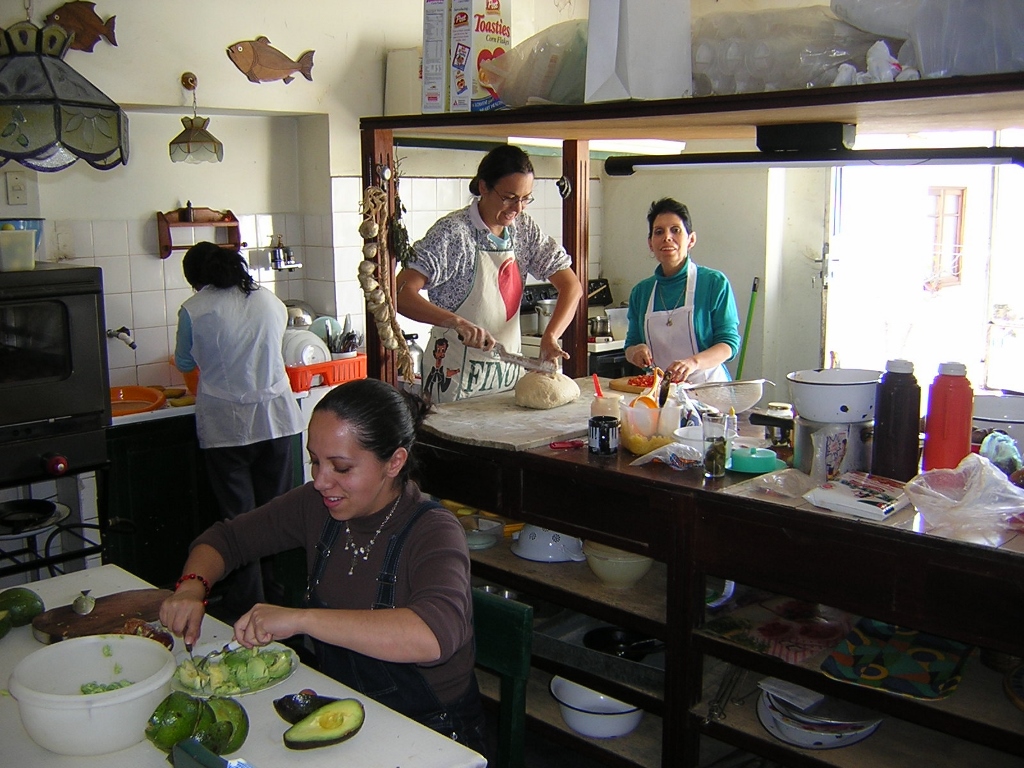 Verica the Cook, with Señora Maria, Ximenita and a girl who helped in the kitchen (Photograph courtesy of GD)
Verica the Cook, with Señora Maria, Ximenita and a girl who helped in the kitchen (Photograph courtesy of GD)
That evening Jose, the eldest brother and Virginia’s friend who in fact invited me to their home in La Paz, came back from his business trip, but I didn’t see him as I had gone to bed earlier. We met the following day. Although he was very kind and pleasant, I saw least of him and thus we spoke little, since we met rarely because he worked a lot and was very busy.
Later on, I went with Ximenita to the centre. First we visited the Witches’ Market. There, in a couple of blocks, there are shops with goods laid down on the shelves outside the shops selling all kinds of things that may be used for healing and different rituals: dried animals, figurines of goddess Pachamama (Mother Earth) and other deities, amulets, herbs, animal wings, shells, starfish, potions, ..., all used by the Aymara.
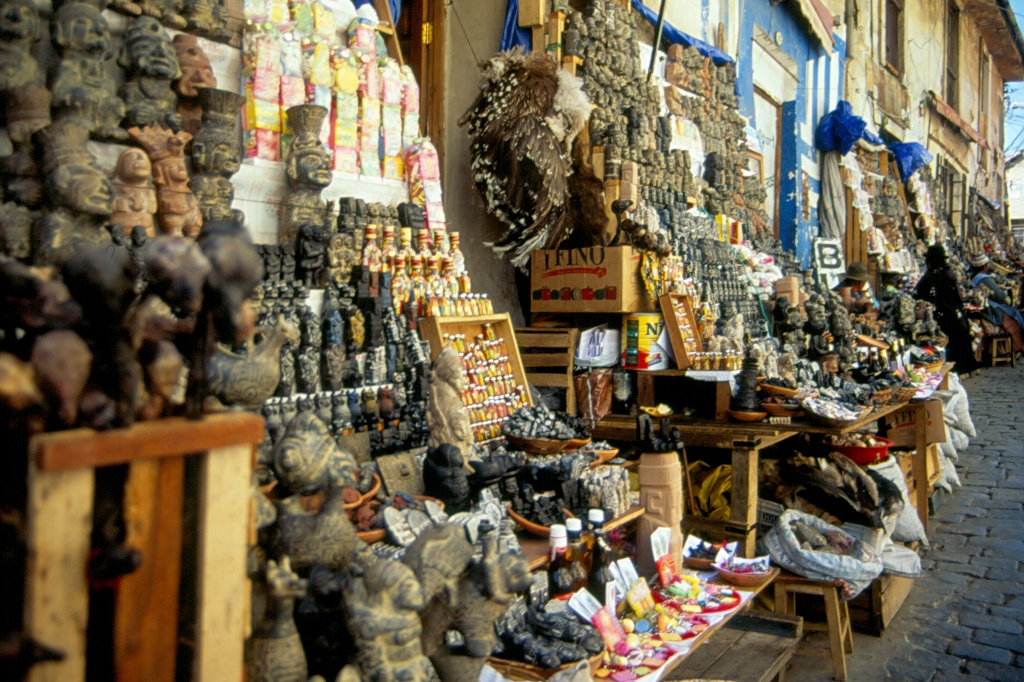 Witches’ Market, La Paz
Witches’ Market, La Paz
Then Ximenita took me to a local flea market. I finally managed to buy a new suitcase that fitted me and I did feel a little clumsy walking around the city with it, but I survived in the end. We returned home for lunch and I later went back “up” to the centre in order to buy plane tickets to Santa Cruz and Sucre.
Namely, I worried a little about the rest of my journey since the coach distances seemed frightening (14 to 18 hour drives), but as the plane tickets were not too expensive, I decided not only to avoid long road trips, but also to gain some time in order to be able to see as much as possible.
I took advantage of my suitcase-free visit to the centre of La Paz and wondered around a little more. I had already mentioned that La Paz appears as if pouring down a large slope and it actually has several small rivers that run down through it. Unfortunately, because of the city’s development, they are mostly covered by some concrete tunnels. Only one of them can be seen properly. However, this is not the only problem. The local population does not care too much for natural beauties and thus these mini-valleys are covered in garbage, which makes Señora Maria really angry. She is very worried about the adverse environmental impact and the overall pollution of everything, so she told me a lot about how from one year to the next there is less and less snow on Illimani and that this would probably lead to serious problems with water supplies in the future.
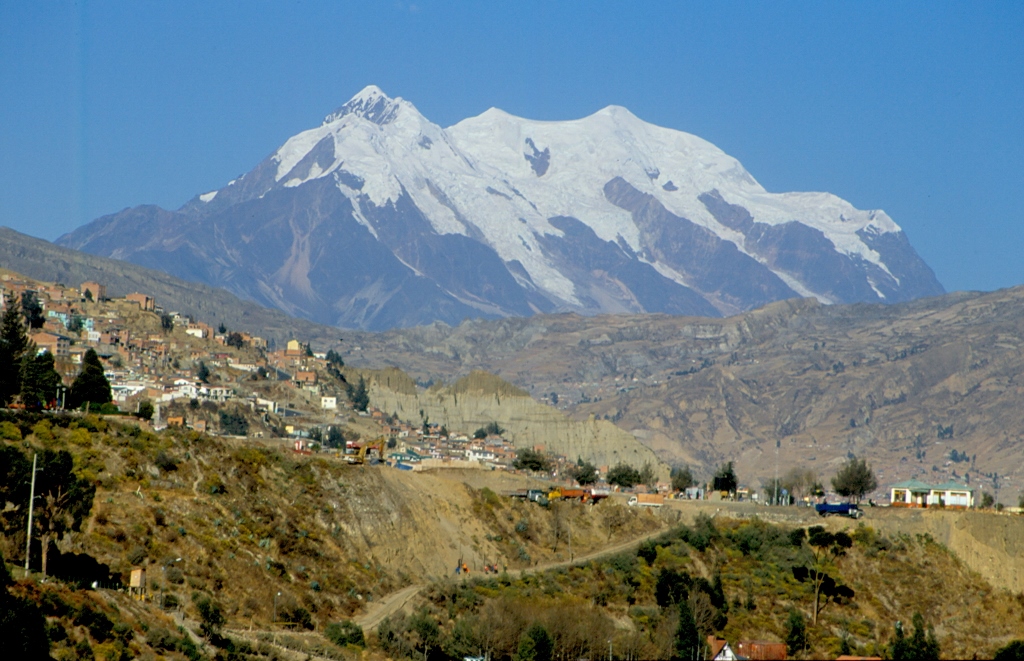 The almighty Illimani
The almighty Illimani
Walking around the city, I also bought a couple of crystals, including a piece of ametrine, here called bolivianite. Namely, the only commercial ametrine mine in the world is located in Bolivia, near Santa Cruz. This is the only place where amethyst and citrine can be found in such a form that they constitute a completely new mineral and its beauty lies in the fact that its crystals and processed semi-precious stones are half purple half yellow.
When I returned home I found two family friends who had come to help with the preparation of food for the birthday party. I didn’t feel well for a little while, again some weakness came over me, and when I mentioned it to Señora Maria she said it was completely normal since that day I went twice up and down, which is too abrupt a change of altitude for somebody not really used to that. The Durans lived in Zona Sur (South Zone), i.e., almost 1000 m lower than the downtown area (which was in fact UP!) The problems were, however, soon over and I could join the action in the kitchen where we stayed until late.
The next day everything went easy. I helped in the kitchen a little bit, watched some film and started to organize which things I would leave in La Paz and which I would take with me for the tour around the country. In the afternoon I washed my hair and made up a little.
The guests started to arrive from 7 pm on. First came some friends and soon after came musicians, as well as dancers. There were a lot of people and the atmosphere was joyful, loud and fun. I filmed a lot of the events by my video camera, but I also managed to eat, as well as to dance. And these were all local dances, but I believe I was good!
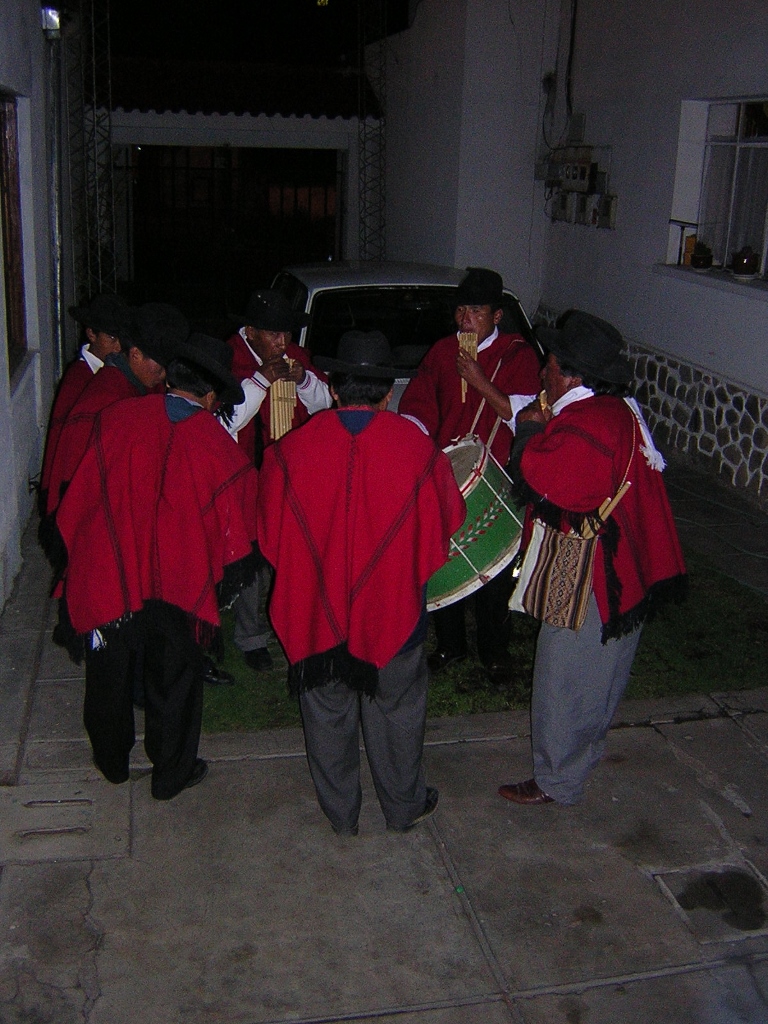 Musicians are warming up (Photograph courtesy of GD)
Musicians are warming up (Photograph courtesy of GD)
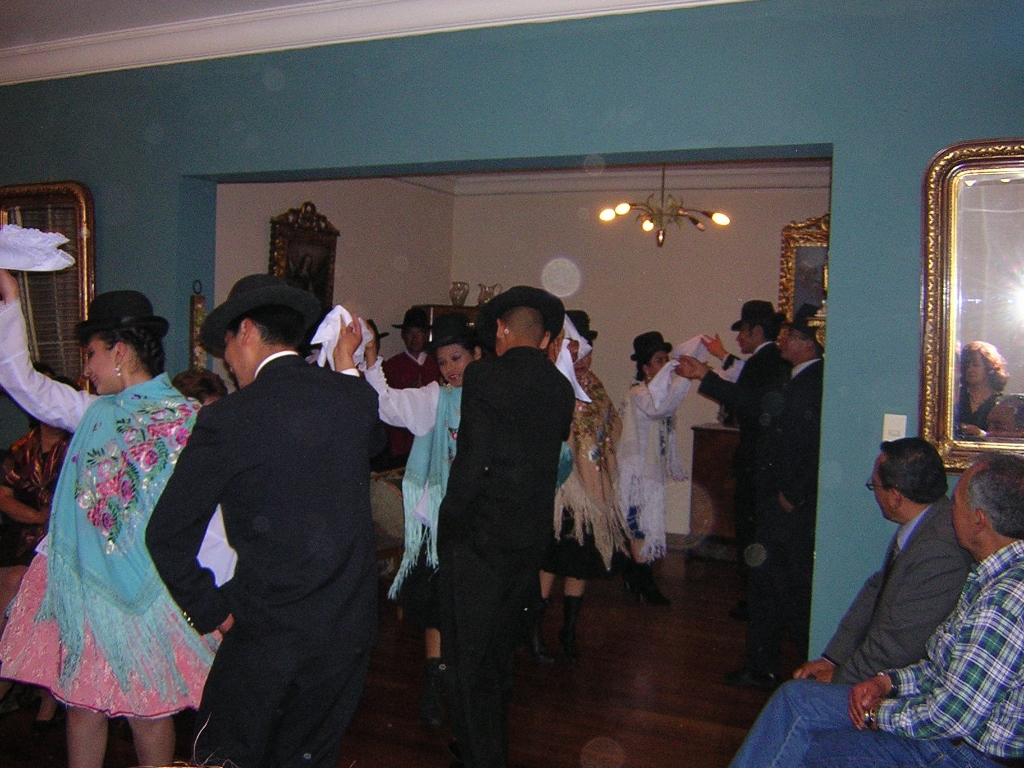 Fiesta in full swing (Photograph courtesy of GD)
Fiesta in full swing (Photograph courtesy of GD)
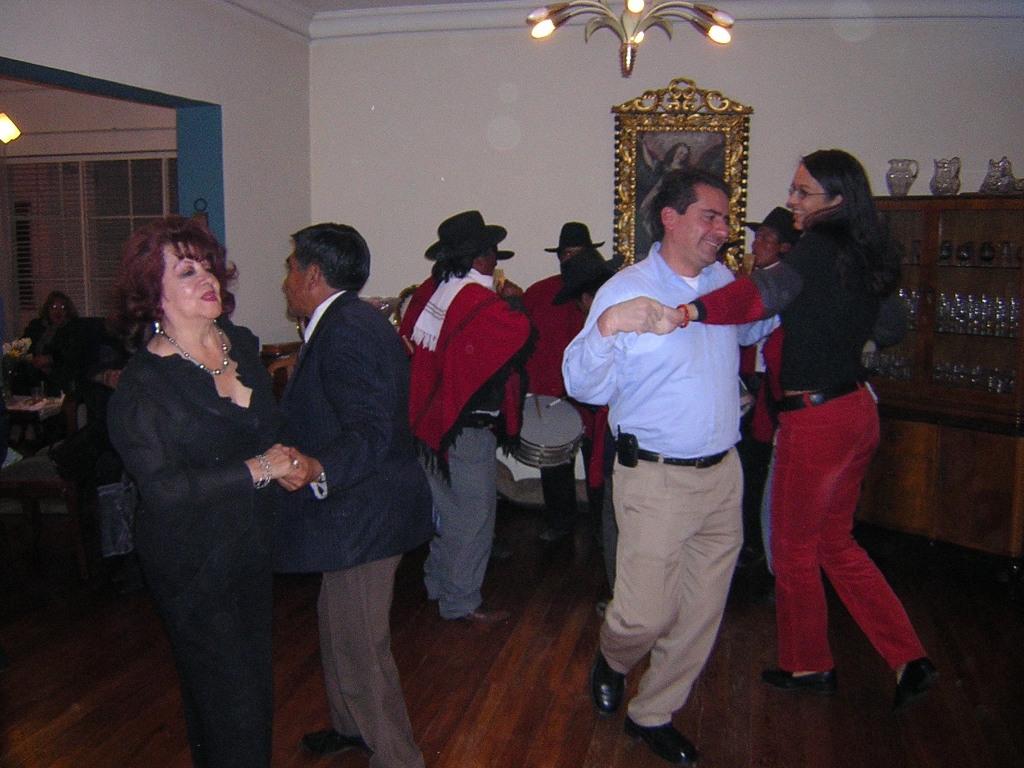 Everybody's dancing (Photograph courtesy of GD)
Everybody's dancing (Photograph courtesy of GD)
Although we stayed until late, the next day we were to go to tango lessons and I certainly did not want to miss that. Ingrid, a cousin, also came, so Gustavo, she and I went to the class. There it was as if I had grown up with the other students: greetings and kisses all over the place, like with the old friends.
Afterwards we walked for a while through the crowd in the city as the University celebration was taking place on that day. As opposed to the main rehearsal, this was the real thing with costumes and blocking of the entire city centre. The Entrada Universitaria is a very important and appreciated event in the yearly calendar, so a lot of people recommended it to me to go and see it.
We also stopped at a cevicheria. This is the place where one can eat ceviche: fish (most often) that is cut into small pieces and marinated and practically cooked in pure lime juice with seasonings. It is eaten solely in the morning. In the afternoon and evening it is impossible to find, since it is very sour (one does not feel it that much when eating it), so apparently that much acid could harm the stomach if there were not enough time to eat something else afterwards. Ceviche is a very tasty dish, the acidity is far from unbearable, but I was glad to eat later at home some salteñas which Gustavo bought while we were in town. I was quite exhausted, but there was no time for me to rest, as I had to pack in order to catch the evening flight to Santa Cruz.
Señora Maria, Ximena and Gustavo took me to the airport to see me off. It was very kind of Gustavo to offer to take me to the airport, but his mother and sister also wanted to come with us. There was a likelihood that Señora Maria would be away on a trip and would not be in La Paz when I was to get back. As for my dearest Ximenita, she simply wanted to come along in order for us to spend some more time together. The Duran family is one incredible and fantastic group of wonderful people and I was enormously lucky to have met them. They bestowed so much kindness, love and affection on me that I don’t think I will ever find enough words to express my gratitude and appreciation. I would love it if I could ever reciprocate to any one of them, but we live so far away that I’m not sure this desire of mine will ever come true.